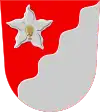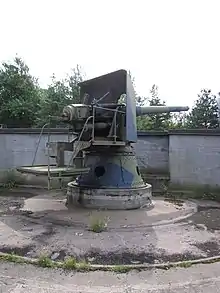Lemi
It is located in the South Karelia region. The municipality has a population of 2,965 (31 July 2020),[2] which make it the smallest municipality in South Karelia in terms of population. It covers an area of 262.48 square kilometres (101.34 sq mi) of which 44.71 km2 (17.26 sq mi) is water.[1] The population density is 13.62 inhabitants per square kilometre (35.3/sq mi).
Lemi | |
|---|---|
Municipality | |
| Lemin kunta Lemi kommun | |
 Coat of arms | |
 Location of Lemi in Finland | |
| Coordinates: 61°03.7′N 027°48.3′E | |
| Country | |
| Region | South Karelia |
| Sub-region | Lappeenranta sub-region |
| Charter | 1688 |
| Municipality | 1867 |
| Government | |
| • Municipal manager | Simo Luukkanen |
| Area (2018-01-01)[1] | |
| • Total | 262.48 km2 (101.34 sq mi) |
| • Land | 217.77 km2 (84.08 sq mi) |
| • Water | 44.71 km2 (17.26 sq mi) |
| Area rank | 255th largest in Finland |
| Population (2020-07-31)[2] | |
| • Total | 2,965 |
| • Rank | 223rd largest in Finland |
| • Density | 13.62/km2 (35.3/sq mi) |
| Population by native language | |
| • Finnish | 97.9% (official) |
| • Swedish | 0.1% |
| • Others | 2% |
| Population by age | |
| • 0 to 14 | 18.1% |
| • 15 to 64 | 62% |
| • 65 or older | 19.9% |
| Time zone | UTC+02:00 (EET) |
| • Summer (DST) | UTC+03:00 (EEST) |
| Municipal tax rate[5] | 19.5% |
| Climate | Dfc |
| Website | www.lemi.fi |
Lemi is a municipality of Finland.
The municipality is unilingually Finnish. The Finnish thrash metal band Stam1na is from Lemi. In 2018 Lemi won the title heavy metal capital of the world that was determined by number of bands per capita. Lemi had 13 regognised bands but due to Lemi only having just 3,076 inhabitants won with ratio of 422.6 bands per 100,000 inhabitants.
Geography

The municipal center of Lemi is Juvola. The other villages are Ahtiala, Hakulila, Heikkilä, Huttula, Hyvärilä, Iitiä, Juuresaho (prev. Remunen), Juvola, Kaamanniemi, Kuukanniemi, Kapiala, Keskisenpää, Korpela, Kurkela, Kärmeniemi, Laakkola, Lavola, Merenlahti, Metsola, Mikkola, Mikonharju, Nisola, Nuppola, Olkkonen, Parkkola, Pöllölä, Ruohiala, Ruomi, Sairala, Sorvarila, Suomalainen, Suoniala, Suontakainen, Sutela, Taipale, Tevaniemi, Torvenniemi, Tuomelanpelto (partly belongs to Iitiä), Uiminniemi, Urola, Vainikkala, Välikangas and Värtölä.
The schools are in Juvola and Kuukanniemi. There are about 750 inhabitants in Kuukanniemi and the villages it affects.
Attractive natural and historical places

| Name | Place | Description | WGS 84 |
|---|---|---|---|
| The evangelic-Lutheran church of Lemi | |||
| Juvolan mörssäripatteri – The mortar battery of Juvola | Juvola | The partly restored position of four positions of the 280 mm mortar of the year 1877. The four mortars are destroyed after the Continuation War.[6] The battery has been a part of the Salpa Line | |
| Kärmeniemen patteri – The battery of Kärmeniemi | Juvola | The position of two Canet 152/45 C guns. The guns are displaced [7] The battery has been a part of the Salpa Line |
History
Independence
Lemi has been founded in 1688 as an independent Evangelic-Lutheran parish. Due to the secularisation of the local governments according to the decree of 1865, the secular local government was separated from the clerical in 1867 as the municipality of Lemi.
War time

Some fighting took place in the cemetery of Lemi during the civil war in 1918. After the winter war as the military hardware had to be displaced from the territories to be given to the Soviet Union on the bases of the Moscow Armistice, naval artillery was brought to Lemi to create part of the Salpa Line. From the Käkisalmi region the Vahtiniemi battery was transferred to Kärmeniemi consisting two Canet 152/45-C naval guns. Later, on 11 July 1941, they were taken to Antamoinen to be tested on 22 July. Four days later they were transported by train from Lappeenranta again near Käkisalmi to Vahtiniemi to become operational 9 September 1941. After the Continuation War the 32nd heavy battery brought only one of the two Canet 152/45-C's it had as the other was to repaired. By the end of November 1944 the 32nd heavy battery was dissolved and the guns were sent to Parola.[8]
After the war there has not been naval guns in Lemi, but the remaining positions can be seen both in Kärmeniemi and Juvola.
Notable individuals
- Elias Muukka, painter
- Mirja Hietamies, Olympic champion cross-country skier
- Stam1na, trashmetal band
References
- "Area of Finnish Municipalities 1.1.2018" (PDF). National Land Survey of Finland. Retrieved 30 January 2018.
- "Suomen virallinen tilasto (SVT): Väestön ennakkotilasto [verkkojulkaisu]. Heinäkuu 2020" (in Finnish). Statistics Finland. Retrieved 13 September 2020.
- "Population according to language and the number of foreigners and land area km2 by area as of 31 December 2008". Statistics Finland's PX-Web databases. Statistics Finland. Retrieved 29 March 2009.
- "Population according to age and gender by area as of 31 December 2008". Statistics Finland's PX-Web databases. Statistics Finland. Retrieved 28 April 2009.
- "List of municipal and parish tax rates in 2011". Tax Administration of Finland. 29 November 2010. Retrieved 13 March 2011.
- "39. Juvolan patteri". lemi.fi. Archived from the original on 2013-09-28. Retrieved 2012-04-06.
- "27. SALPALINJA / KÄRMENIEMEN PATTERI". lemi.fi. Archived from the original on 2011-07-20. Retrieved 2012-04-06.
- "27. SALPALINJA / KÄRMENIEMEN PATTERI". lemi.fi. Archived from the original on 2011-07-20. Retrieved 2012-04-06.
External links
![]() Media related to Lemi at Wikimedia Commons
Media related to Lemi at Wikimedia Commons
- Municipality of Lemi – Official website
- goSaimaa.com – travel information
